The Rental and Staging Roadshow was held on August 2nd at the Metropolitan Pavilion West in New York. It was produced by the media company NewBay Media and co-hosted by the rental and staging company WorldStage. There were multiple talks and panel discussions about rental and staging topics, including several of interest to the display community. They included a talk about selecting LED video walls, (See my DD for the 9th of August How to Chose a LED Videowall ); a panel on disruptive technologies such as AV over IP and LED videowalls replacing projectors a talk by Bill Beck, Barco’s “laser guy” on laser-phosphor projectors; and a talk and panel discussion on the explosive growth of music festivals. Since large-scale displays are not commonly used in this new generation of music festivals, I will not discuss them further.
Disruptive Technologies
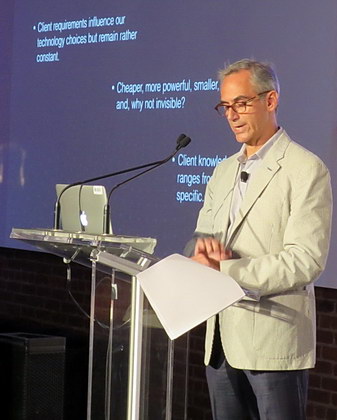 Josh Weisberg, President of WorldStage (Credit: M. Brennesholtz)
Josh Weisberg, President of WorldStage (Credit: M. Brennesholtz)
One of the key disruptive technologies discussed by Josh Weisberg, President of WorldStage, in his talk titled “Managing Change in a Technology-Driven Industry” was the replacement of projectors and other display types by LED video wall modules. He said the sweet spot for the main LED video walls used by rental and staging was in the 7 – 9mm range but he expects there to be a place for the super high-resolution units, under 2mm, as well. These probably won’t be cost-effective for rental and staging until ‘chip-on-board’ (COB) technology is implemented by the manufacturers, which he believes will happen in the 2018 – 2019 time frame. The technology should be able to provide durable, high reliability LED displays that can withstand the rigors of the staging business. These probably won’t replace the main large displays, but already fine pitch LED displays are sometimes used in small arrays facing the performers and speakers.
In terms of projection, Weisberg sees laser-phosphor projectors replacing lamp-based projectors he said “Client demand for projectors that are smaller, quieter, with as much or more brightness than comparable lamp units is very strong. Laser-phosphor is perceived to provide this advantage.” This is a change from even a few years ago when laser-phosphor projectors were typically bigger and more noisy than lamp-based projectors. One of the issues this creates for the rental and staging industry is the potential obsolescence of the current projector fleets. I talked with two of the three projector manufacturers demonstrating at the roadshow, Barco, and Epson, and they both agree that laser-phosphor projectors are the wave of the future for this market. In fact, the three projector companies at the roadshow, Barco, Epson and Christie were only demonstrating laser-phosphor projectors at the roadshow. Christie, without a high-brightness laser-phosphor projector targeting the rental market, was demonstrating a boardroom projector.
Weisberg also discussed the future of signal distribution. He said rental and staging clients are demanding higher resolution, higher frame rates and HDR, all of which can dramatically increase the needed bit rates. 4K 60Hz HDR is commonly being demanded now but he said some clients have asked for 8K. He said 3G SDI simply cannot support these images and 12G SDI isn’t quite ready yet. The problem is not just a single signal – some clients want up to 20 different 4K HDR 60Hz images! This connectivity issue applies not just to video but to sound as well. He warned against sound over IP where a single network failure can bring down all sound at a staging event. With conventional sound technology, it is not uncommon to lose a single channel of sound. This allows the rest of the sound to continue and for the conventional sound technicians to troubleshoot the problem. Anyone who uses video or sound over IP should have an IT person on site at the event and most video and sound staging people simply don’t have the IT skills.
Weisberg also discussed Broadway shows, which are very technology-driven these days. He said there is a trend away from projection on Broadway in favor of LED video walls. Still, he said, there are some artistic designs that simply cannot use LED videowalls and projection is the only solution so projection is not going to vanish from the Broadway stage. He also discussed the business model of Broadway and how it differed from normal rental and staging. In particular, rental and staging companies help Broadway with the installation and training, but have no long-term involvement in the show, which is operated by Broadway people, not rental and staging people. Of course, the rental and staging people do not generate the content for Broadway, the way they commonly do for normal staging events.
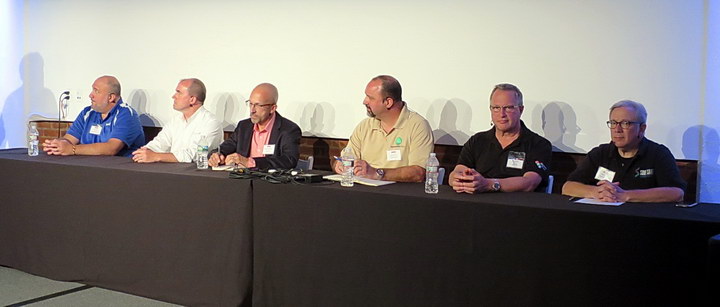 Panel on disruptive technology and rental and staging. Left to right: Gary Bettan, Broadfield Distributing; Greg Byrnes, Lightware; Don Guzaukis, HB Live; Frank Fehrenbach, Nationwide; Jeff Studley, CPR; Marty Karp, ShowSage. (Credit: M. Brennesholtz)
Panel on disruptive technology and rental and staging. Left to right: Gary Bettan, Broadfield Distributing; Greg Byrnes, Lightware; Don Guzaukis, HB Live; Frank Fehrenbach, Nationwide; Jeff Studley, CPR; Marty Karp, ShowSage. (Credit: M. Brennesholtz)
Following Weisberg’s talk, there was a panel discussion titled “Disrupting the AV Staging World– New Technologies, and New Business Models, Push the Envelope for Stagers.”
Much of the panel discussion focused on aspects of video distribution, switching and recording. Guzaukis said he’s worked events where the client wanted 16 channels of 4K HDR 4:4:4 which put a strain on everything, which included switching and storing the content for post-event use. He said the client finally agreed to 4:2:2 video, which was still an awful lot of data. Fehrenbach distinguished between AV over Cat6 cable and AV over IP and said it was possible to use the Cat6 cables now but not necessarily the IP protocols. While he didn’t mention it by name, presumably by AV over Cat6, he meant HDBaseT. Others agreed that networked Video over IP was not really ready for rental and staging, even over closed, location specific networks. Since installed AV is a much larger market than rental and staging, Karp said he was willing to let them take the lead on Video over IP. Fehrenbach agreed and mentioned that sports was another market that always wants to be on the leading edge of video technology and would also provide impetus for video over IP. Bettan was concerned about hacking (Aren’t we all!) and was afraid a hacker could stream a live event that costs $300 to attend for free to all comers.
One trend in the industry discussed by several of the panelists was the existence of pre-wired and setup staging venues, including seven in New York. These are especially useful for things like corporate events that occur at regular intervals such as quarterly meetings. Their ability to be set up in multiple ways allows the same venue to provide many different looks for live events. Given a dedicated live events venue, there is less need for rental and staging people and the company involved needs to supply content and management but not hardware.
Laser-Phosphor Projection for Rental and Staging
At his third appearance at the Rental and Staging Roadshow, Barco’s Bill Beck discussed the advances in laser-phosphor projection in the rental and staging marketplace with a talk titled “Laser will Rule in Events and Venues.” It’s clear where Beck stands on the laser-phosphor vs lamp debate. He provided the technical background for laser-phosphor, including terminology, projector measurement, color gamuts and how laser-phosphor technology works. While this might not be well known to the typical worker in the rental and staging industry, it should be familiar to readers of Large Display Monitor. One thing Beck emphasized is the speed with which laser-phosphor technology has moved into rental and staging, as shown in the image.
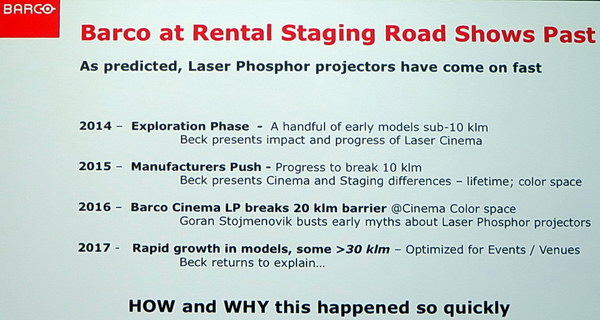 The progress of laser-phosphor projectors in the rental and staging market since 2014 (Credit: Barco/Bill Beck)
The progress of laser-phosphor projectors in the rental and staging market since 2014 (Credit: Barco/Bill Beck)
While I’ve been following both laser-phosphor technology and the rental and staging market since before 2014, seeing the progress in commercially available projectors from under 10K lumens in 2014 to more than 30K lumens in 2017 summarized so simply surprised even me. While laser-phosphor and hybrid projectors have been available since about 2011, the ones before 2014 were all well under 10K lumens and of little interest to the rental and staging market. At 30K+ lumens, laser-phosphor projectors are not only mostly eliminating the sales of future lamp-based projectors in this market but are threatening the ability of rental and staging companies to rent their existing inventory of lamp-based projectors. He used as a case study of high brightness laser-phosphor projectors the Barco UDX-4K32 projector with 31,000 lumens output in a smaller and lighter package than the previous generation of xenon-based Barco projectors that are common in the rental and staging industry. I suspect not coincidentally, Barco was showing the UDX-4K 32 in their booth at the roadshow exhibition – more about that later.
Beck made three projections for the future. First, he expects that laser projectors with up to 60K lumens will be available in the future, especially for projection mapping applications. He believes these projectors are likely to be pure laser, not laser-phosphor. Second, he said there will be a proliferation of specialized 4K models that are brighter, smaller and lighter than existing projectors. To me, this seems inevitable, given past progress, and, almost, hardly worth stating. Finally, he predicted projectors with centralized light farms with small projection “appliances” connected via fiber optics. This forecast I, personally, strongly disagree with. It has become too easy to build very high output laser-phosphor light sources into the projector itself and remains too difficult and expensive to distribute the 200+ watts of light via fiber optic cable from an external light source to a projector head for this to be practical. One of the difficulties is safety – when a fiber carrying this much power breaks, there is a distinct safety hazard. One of the expense items is the loss of light transmitted through the cable – if you need 30K lumens at the projector head, with a long cable you might need to put in 60K lumens at the light farm. Put this light source in the projector and you can double the projector output.
Barco UDX-4K32 Projector
 A Barco UDX-4K32 projector being examined by a potential customer at the roadshow. (Credit: M. Brennesholtz)
A Barco UDX-4K32 projector being examined by a potential customer at the roadshow. (Credit: M. Brennesholtz)
Barco was showing its new UDX-4K32 laser-phosphor rental projector in their booth, which was discussed before by Display Daily. Unfortunately, it wasn’t operating, in part because of the limited size of the roadshow venue. This projector has proven to be very popular since its introduction March 30th this year and, reportedly, about 300 units have been shipped. Lang, for example, has taken 33 units. Reportedly, 16 of the projectors have been used in a projection mapping project in China and TDC in Australia, who took the first deliveries, used them in a projection mapping project in Sydney.
Barco is planning on producing 5 different versions of the UDX projector. The UDX-4K32 has 31K lumens and 3,840 x 2,400 resolution which is produced by pixel shift from three 2,560 x 1,600 0.9” DLP imagers, the UDX-W32 with 1920 x 1200 resolution and 32K lumens, the UDX-U32 with 1600 x 1200 resolution and 30K lumens, the UDX-4K22 with 3840 x 2400 resolution and 21K lumens and the UDX-W22 with 1920 x 1200 resolution and 22K lumens.
MSRP on the UDX-4K32 projector is $122K, including the projector, a standard lens, the cage and the case, as shown in the photo. The projector uses Barco’s TLD+ lenses which are already in the inventory of many rental and staging companies since they have been used in Barco projectors for about 10 years.
Epson Pro L25000U and Pro L1405U Projectors
 Epson Pro L25000U with an extra ELPLM13 zoom lens. (Credit: M. Brennesholtz)
Epson Pro L25000U with an extra ELPLM13 zoom lens. (Credit: M. Brennesholtz)
The Epson Pro L25000U and Pro L1405U laser-phosphor projectors were both shown operating with short-throw projection lenses at the roadshow. The L25000 projector was introduced at ISE. This projector has 4K resolution that is achieved, like the Barco UDX-4K32, by using pixel shift. The Epson projector uses three 1920 x 1200 LCD displays so the image isn’t really 4K – it’s UHD. The projector produces 25K Lumens of output.
While most people agree that a 3LCD projector produces a better image than a 1-DLP projector with the same output and resolution, the Epson rep said the image quality of both 3LCD and 3DLP is about the same, given the same resolution and lumen output. He said that the main difference was in price, with 3LCD having a significant advantage over 3DLP.
The Epson Pro L25000U was actually introduced at ISE 2016 but is still a very competitive projector. The MSRP is about $80K. This cannot be compared directly with the $122K for the Barco UDX-4K32, since the Epson price doesn’t include the lens, cage or traveling case that would be needed for the rental market.
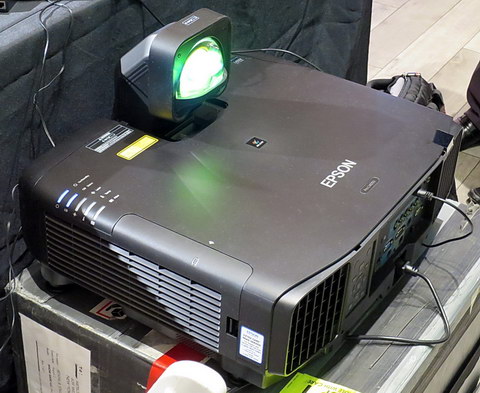 Epson Pro L1405U with an ELPX01 lens. (Credit: M. Brennesholtz)
Epson Pro L1405U with an ELPX01 lens. (Credit: M. Brennesholtz)
The Epson Pro L1405U is a WUXGA projector that uses 1920 x 1200 LCDs and pixel shift to achieve full resolution. It was introduced at ISE 2017, where I saw it, and shown at the roadshow with an ultra-short throw ELPLX01 lens with a throw ratio of 0.35:1. Lumen output was 8K lumens although the Epson rep told me the company was coming out with a 10K – 12K lumen version of the projector later this year.
Christie DHD850-GS
The Christie DHD850-GS was the only single-chip DLP projector shown at the roadshow. It uses Christie’s BoldColor Technology where two different laser colors are used – blue and red. The blue is used directly to produce the blue light and indirectly with a yellow phosphor to produce green and red light. The red lasers then enhance the red light from the phosphor to produce a more saturated red. This BoldColor technology is actually the patented Multi-Color Light Architecture (MCLA) technology from Coretronic and shown by both Coretronic and Christie at ISE. The Christie rep at the roadshow admitted that they got their BoldColor light engines from Coretronic.
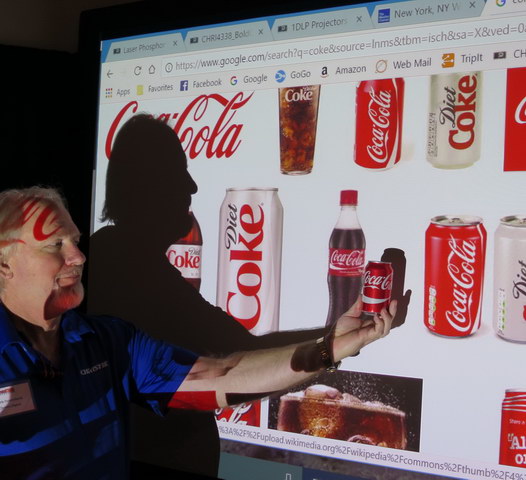 Coca-Cola Red on a can compared to the Coca-Cola red produced by the Christie DHD850-GS from Internet content whose color grading is unknown. (Credit: M. Brennesholtz)
Coca-Cola Red on a can compared to the Coca-Cola red produced by the Christie DHD850-GS from Internet content whose color grading is unknown. (Credit: M. Brennesholtz)
While the BoldColor/MCLA technology is intended to enhance red colors, the projector is still a Rec. 709 projector and, when showing Rec. 709 content shows little red enhancement. For example, the Coca-Cola red is a notoriously difficult color to produce on displays, especially Rec. 709 displays. Using Internet content to show images of Coca Cola products, the DHD850-GS at the roadshow couldn’t fully reproduce the color, as shown in the image. The DHD850-GS has a list price of $11,995. While Christie was showing the projector at the Rental and Staging Roadshow, that isn’t the projector’s primary market. Christie says the projector targets the boardroom, higher education, houses of worship and smaller location-based entertainment venues. I would guess it was brought to the roadshow because of the ease of shipping it, compared to the many large venue projectors made by Christie. Perhaps another reason is all the Christie large venue rental projectors are based on mercury or xenon lamps, not the laser-phosphor systems that the rental and staging market is beginning to demand. I wonder when Christie will produce a laser-phosphor Roadie-series projector to target this market?. –Matthew Brennesholtz

